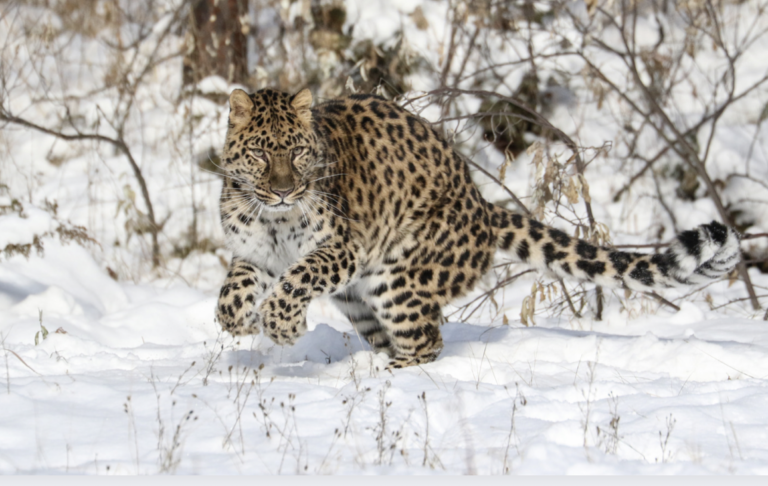Species in Peril:
Amur Leopard

A solitary cat with a precarious future
Do well in harsh weather
The Amur leopard lives in a region of roughly 7,000 km squared in the Russian Far East (2,700 sq mi). It does well in the region’s harsh climate and significant snowfall. There is evidence that the leopard prefers high terrain, particularly in winter when snow is absent from south-facing rocky slopes. It is mostly restricted to areas with wild sika deer (Cervus nippon) or areas with active deer husbandry.
Despite a high and long wire fence defining the border, leopards pass between Russia, China, and possibly North Korea across the Tumen River.
Behavior
Except when females have young, Amur leopards live alone like other leopard subspecies. They are more diurnal (active during the day) than nocturnal (active at night) and crepuscular (active at dawn and dusk) during the summer and the winter, according to camera-trap data. This activity pattern corresponds with the activity periods of prey species including the Ussuri wild boar and Siberian roe deer. Amur leopards are very selective in the areas they choose to roam. A person’s territory is typically found in a river basin that typically reaches the region’s natural topographical boundaries.
Leopards follow herds of ungulates and live in areas where wild animals are common. Siberian roe deer, Manchurian sika deer, Manchurian wapiti (Cervus canadensis xanthopygus), Siberian musk deer (Moschus moschiferus), Amur elk (Alces alces cameloides), and Ussuri wild boar are their primary prey in the Ussuri region.
They also catch mice, birds, hares (Lepus sp. ), and Asian badgers (Meles leucurus). Roe deer are their primary food all year long in the Kedrovaya Pad Nature Reserve, but they also hunt on young Asian black bear (Ursus thibetanus) cubs under the age of two. Leopards have expansive home ranges that can reach 100 km2 when the population of ungulates is low (39 sq mi).
In Danger of Extinction
Threats to the Amur leopard include habitat loss, deforestation, and poaching of both individuals and prey animals. The development of new highways and forest fires are threatening its natural habitat.
Because there aren’t many Amur leopards that reproduce in the wild, there isn’t enough genetic variety in the gene pool to prevent inbreeding depression. The canine distemper virus was discovered in a wild Amur leopard in Primorskyi Krai in 2015.
Due to the limited population, potential exposure to domestic or wild disease carriers and transmitters is a possibility for all wild animals.
A Few More Facts About the Amur leopard
- They are solitary
- They are the rarest big cat left in the world
-
Amur Leopards are excellent swimmers.
-
Amur Leopards have long bushy tails
-
Amur Leopards can run at speeds of up to 37 miles per hour
-
The Amur Leopard population has doubled since 2007, thanks to conservation efforts!
-
One leopard needs at least 20km squared to live
Species Name
Panthera pardus orientalis
Estimated Population
Approx. 120
Conservation Status
Critically endangered
Range
Eastern Russia, Northern China, North Korea
Reasons for Population Decline
Habitat loss
Deforestation
Poaching


